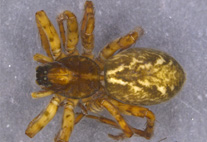Abstract
Two new genera Makarovaia and Hispiniphis are described from adults and immatures of newly described species associated with hispine beetles of the genera Chelobasis and Cephaloleia, respectively, occupying unfurled leaves of Heliconia in lowland rainforest of Costa Rica. The new genera share a suite of unique morphological attributes, but are tentatively assigned to the family Melicharidae. While all instars of the mites can be found under the elytra of their adult beetle hosts, adult mites also move freely on and off the beetles. A new form of laboulbeniaceous fungus of the genus Rickia is frequently associated with adult mites of Makarovaia as well as their beetle hosts, yet evidently rarely with mites of a species of Hispiniphis or its beetle hosts which may co-occupy the same host leaves. Limited data suggest considerable host specificity between mites and their beetle hosts. Whether the association of these mites with hispine beetles may be ancient, prior to the beetles’ adaptation to living in unfurled leaves of host plants, or is a more recent invasion and partitioning of the rolled leaf beetle fauna, is discussed.

